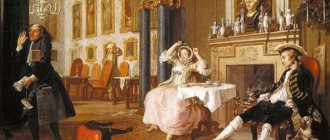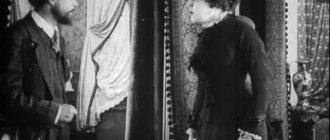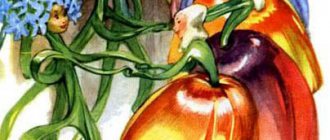A very brief retelling of the story “Viy”
The plot takes place on one of the farms in the vicinity of Kyiv. Bursa student Khoma Brut and his two friends decided to start a part-time tutoring job. Khoma encounters a strange old woman, pacifies the witch, and she turns into a beautiful girl. After this incident, she dies, but before her death she asks her father, Sir, to have Bursak Khoma read prayers over her coffin for three nights in a row. Having received the task from the master, Khoma gets down to business, but he fails to finish what he started; at the end of the third night, looking at the terrible Viy, Khoma dies.
"Viy" very brief summary
N.V. Gogol “Viy” summary for the reader’s diary:
Three seminarians went home on vacation, and on the way they asked to spend the night in the same village. The owner, an old and scary woman, put Khoma to bed in the barn, and at night she came to him, saddled him and went to the Sabbath. The brave guy managed to cope with the witch, but when she died, she turned into a young beauty.
And the next morning they came for him from the governor, demanding that Khoma read the psalter at the tomb of the master’s suddenly deceased daughter for three nights.
When the guy was left in a dark church at night alone with the lady lying in a coffin, he was very scared. As it turned out, this was the same witch who wanted revenge for her death. But he was even more frightened when the witch stood up and began looking for him to avenge her death.
Khoma had to spend three nights over the coffin with the lady in desperate attempts to escape from her spells. Then she called all the evil spirits for help, and, in the end, with the help of Viy, a demonic Slavic creature, the evil spirits defeated the young man.
Conclusion:
Khoma was overcome by his own fear, he was afraid of the witch and evil spirits, and although he was in the temple, he could not find salvation for himself. In my opinion, a person must fight his fears, and then he will become invincible.
This is interesting: The story “The Overcoat” was first published in 1843. To get a detailed understanding of the essence of the work, we suggest reading a summary of Gogol’s “The Overcoat”. She talks about the life of a “little man” in society. He is indifferent to everyone, but sincerely loves his small position. Only one circumstance pulls him out of his usual way of life: the purchase of a new overcoat.
List and brief characteristics of the heroes of N. V. Gogol’s story “Viy”
The main characters of the story “Viy”:
- Khoma Brut is a student of the Kiev Bursa, a lover of “forgetting” about science. A cheerful fellow, a lover of good company. I went to one of the farms in the Kyiv province to start tutoring. He pacified the witch, under whose guise a beautiful girl was hiding. After her death, I read prayers over the coffin. At the end of the third night he died.
- Pannochka is the daughter of the captain and the main villain of the story. A witch who killed many village residents. After death, Khoma is pursued, and at the end of the third night, the witch is helped by evil spirits led by Viy.
- Viy is one of the main opponents of Khoma Brut. Powerful mythical gnome-villain, leader of the gnome country. A distinctive feature is the eyelids that droop to the ground, which are raised by evil spirits. If anyone looks at Viy, death awaits the unfortunate fool.
Minor characters of the story “Viy”:
- The theologian nicknamed Freebie is one of Khoma Brut’s comrades and fellow students. Got a job as a bell ringer. He regrets the death of Khoma.
- The rhetorician Tiberius, nicknamed Gorobets (Sparrow) , is Khoma’s comrade and fellow student. Became a philosopher. It was Tiberius who expressed the opinion that Khoma could have survived if he had not looked into Viy’s eyes.
- The centurion is the owner of the farm. Although he looked askance at Khoma, he did what his daughter asked before his death: he sent the philosopher to church so that he would read prayers over the coffin.
Minor characters
Theologian Freebie
One of the students, Khoma’s friend, who was with him at the mysterious farm. He graduated and now serves as a bell ringer in the bell tower. He regrets the premature death of his comrade.
Rhetor Tiberius Gorobets
The third student from Khoma's company. Now he has become a philosopher, and is making full use of his new privileges - he can smoke tobacco and drink vodka. He believes that if Khoma had not been afraid of evil spirits, he would have been able to survive.
Centurion
The lady's father loves his daughter dearly and is grieving her death. She is suspicious of the philosopher, but fulfills the lady's last wish and invites him to read prayers over her daughter's body. He very much regrets that he will never know who caused the lady’s death and will not be able to take revenge. He promises to pay the philosopher well for his work.
Here is a brief description of the characters in Nikolai Vasilyevich Gogol’s story “Viy”. This material can be used to work on an essay.
Check out what else we have:
for the most impatient -
A very brief summary of “Viy”
for the most sociable -
The main characters of "Viy"
Work test
- /11
Question 1 of 11
Brief summary of N. V. Gogol’s story “Viy” in detail by chapter
Chapter 1
The reader gets acquainted with the life and customs of the Kyiv bursa and seminary. There were traditional fights, which left the rhetoricians with marks on their faces, such as a swollen lip or a “lantern” under the eye. It was impossible without theft - for the students and seminarians were as poor as church mice.
When summer began, school ended, and the students and seminarians began to look for work. Usually it was tutoring.
Chapter 2
Three fellow students - the merry philosopher Khoma Brut, the rhetorician Tiberius nicknamed Gorobets, the theologian nicknamed Freebie - turned off the beaten path and went in search of a farm where they could tutor. The rhetorician was a desperate bully, the theologian a kleptomaniac who stole everything he could lay his hands on, and Khoma was a philosopher whose motto was: “what will happen cannot be avoided.”
The evening dawn gradually burned out, but the farm was still not visible. And when it was already late at night, the friends finally reached the farm. There were only a couple of huts there, and when the students knocked on the gate, an old woman appeared. Having managed to persuade her, the friends were able to spend the night normally under the roof. True, in different places.
Chapter 3
Another surprise awaited Khoma: the old woman entered the barn and looked at her in such a way that the unfortunate philosopher was bewitched. Having mounted him like a horse, the witch spurred Brutus with a broom. And only while running, when it was impossible to stop, did Khoma realize that he had fallen under the grip of a real witch. True, with the help of phrases-spells, the philosopher managed to pacify the obnoxious rider, and then he himself saddled her. However, the troubles only continued, and ended at the moment when the unwitting rider hit the witch with a log. Dawn came, and the old woman turned into a young beautiful girl. Frightened Khoma ran as fast as he could to the farmstead.
Having managed to eat normally and collapsed into the tavern, the young philosopher forgot about the night’s adventure, when he suddenly heard the news: the rich centurion’s daughter returned to her father’s house, and the girl was beaten half to death. The girl is dying, and her last wish is to let Khoma Brut sing for her, and let him pray for three nights after her death. The centurion gave the Cossacks a task: to bring Khoma.
Chapter 4
On the way, Khoma learned that the girl had died. Cats scratched at the philosopher’s soul, and Brutus understood that things were bad. And when he saw the dead lady and looked closely, he was horrified to recognize her as a witch. The centurion himself regretted that he did not know who exactly killed his daughter. Only the readers guessed that it was Khoma Brut who became the killer.
Having learned about what terrible atrocities the fatal beauty committed, how many people died from her tricks, the philosopher was pretty nervous before the night service. When the church was locked, Khoma lit candles and began to read prayers. Soon a misfortune struck: the witch crawled out of the coffin, and Khoma drew a circle with chalk, stood inside it, and began to speak spells. Without breaking through the circle, the witch returned to the coffin. And then suddenly a pandemonium began: the coffin was flying throughout the church.
The roosters crowed and the obsession ended. The coffin falls and the lid closes. But that was only the first night.
Chapter 5
On the second night, the main character faced a new misfortune: the witch, with her spells, invoked evil spirits and at the same time cursed Khoma, the witch’s voice was terrifying. When it was all over, the philosopher could barely breathe. When the doors of the church opened and the Cossacks brought Brutus to the centurion’s estate, Khoma learned that he had turned gray due to the witch’s curse. The student decided to return to Kyiv, but the stern centurion clearly explained that the guy had no choice: either he would serve the third night in an amicable way, or he would be flogged and forcibly driven into the church.
The attempt to escape was in vain, and in the end he had to serve. And this time evil spirits burst into the church, and then the witch ordered Viy to be called. A terrible man came, short in stature, walking like a bear. This was Viy. And when his eyelids were lifted, Khoma could not fight the dangerous temptation and looked at the monster. Viy saw the enemy and pointed at him, evil spirits attacked, and Khoma died of fear.
Chapter 6
Freebie and Tiberiy Gorobets learned about the death of Khoma Brut and went to the tavern to remember their comrade. They exchanged opinions, and Tiberius concluded that it was fear that destroyed Khoma Brutus.
Who invented Viya?
“The ladies “turned around” in front of him, bent, showing all their roundness, made oily eyes, sadly asked: “Anton Pavlovich, why do you write so sadly about love?” Coughing and pinching his beard, he answered with unexpected questions: “Have you been to Mirgorod?” "Where is it?" “In the Poltava province. Do you remember Gogol’s “Mirgorod”?” “Oh, so Gogol didn’t make this up?” “Gogol never made anything up.” “Ah... and “Viy”?
The story “Viy”, in all its characteristics, could look great in “Evenings on a Farm near Dikanka”. Here you will find a romantic mystical horror film, and Ukrainian flavor, and irony embedded in the narrative... But “Viy” was written later and published in another collection - “Mirgorod” - in 1835.
At this time - after “Evenings...” and “Nevsky Prospect” - Gogol was already deservedly considered one of the best Russian writers. However, no one freed “the hope of Russian literature” from censorship. So, in the original version of “Viya”, Khoma, looking at the features of the late lady, “saw something terribly piercing”
and
“felt that his soul was beginning to ache somehow painfully, as if suddenly, in the midst of a whirlwind of fun and a swirling crowd, someone was singing a song about the oppressed people
.
The censors did not like
the mention of the “oppressed people” a “funeral”
.
But, thanks to censorship, “Viy” was enriched with a new episode. In the first version, the story ended with the death of the unlucky philosopher. But then the censorship erased two pages from the collection, “The Tale of How Ivan Ivanovich Quarreled with Ivan Nikiforovich,” which just followed “Viy.” As a result, in order not to revise, Gogol completed the final conversation between Khoma’s friends, Khalyava and Tiberiy Gorobets ( “After all, in Kiev, all the women who sit in the market are all witches.”
).
Also, during the alteration, the writer himself already changed another episode. In the first version, Khoma kills the witch and abandons her without looking, so when he arrives to perform the funeral service for the lady, he does not recognize the deceased (leaving the loose ends to be tied up by the quick-witted reader). In the new version, he sees the “rejuvenation” of the witch and guesses who he will have to deal with.
The writer prefaced his story with a note: “This whole story is a folk legend. I didn’t want to change it in any way and I’m telling it in almost the same simplicity as I heard it.”
. Here Gogol, of course, is being disingenuous, although similar stories are indeed common in the folklore of many countries and they exist in many variations.
In some stories, the hero must spend three nights at the tomb of a demon-possessed princess. After all the horrors accompanying the ordeal, the princess “recovers” and the hero takes her as his wife. In other stories, the fearless hero wants to experience fear for the first time and stands vigil at the coffin of a dead witch. To hide from the deceased, the hero either stands in the altar, then lies down in the coffin when the deceased gets up from it, and lies there until the third rooster. But the closest to Gogol's version is a fairy tale in which a witch's daughter falls in love with a guy and comes to him, turning into a black cat. The guy puts a bridle on the witch and rides her until she dies. For this, the parents of the murdered woman demand that the guy read the psalter near the coffin for three nights. For two nights the guy is haunted by all sorts of nightmares, from which he takes refuge by delineating a forbidden circle. On the third night, the evil spirits turn to the “elder witch” for help, she finds the guy, but at this time the roosters crow, and the hero (as a rule) remains alive.
Everything is more or less clear about the sources of the plot. But researchers have been tormented by the question for many years: who is Viy, who serves as Gogol’s “senior witch”? The writer himself wrote in a note to the story that “Viy is a colossal creation of the common people’s imagination. This is the name given to the chief of the dwarves, whose eyelids go down to the very ground.”
. And here Gogol, most likely, openly mystified the reader.
N. Gogol “Viy”:
“...soon heavy footsteps were heard throughout the church; Looking sideways, he saw that they were leading some squat, hefty, club-footed man. He was all covered in black earth. His legs and arms covered with earth stood out like stringy, strong roots. He walked heavily, constantly stumbling. Long eyelids were lowered to the ground. Khoma noticed with horror that his face was iron. They brought him by the arms and stood him directly in front of the place where Khoma stood. - Lift my eyelids: I can’t see! - Viy said in an underground voice - and the whole host rushed to lift his eyelids. “Don’t look!” whispered some inner voice to the philosopher. He couldn’t bear it and looked. - Here he is! - Viy shouted and pointed an iron finger at him. And everyone, no matter how many there were, rushed at the philosopher. Lifeless, he fell to the ground, and the spirit immediately flew out of him out of fear.”
Of course, I came across books like all sorts of dictionaries of Slavic mythology, where Viy is conscientiously classified as a folklore character. But there is no such character in folklore. There are those similar to him, endowed with some of his features, but there are none exactly like Gogol’s.
The origin of the name does not create any special mysteries and refers us to the Ukrainian word “vіya” (that is, an eyelash, or an eyelid with eyelashes). Similar long eyelids are found in many folklore characters. In the fairy tale “Ivan Bykovich” from Afanasyev’s collection there is a witch’s husband whose eyelashes are so long that as many as 12 heroes lift them with pitchforks! True, this character’s eyes do not have any magical powers. Long eyelashes are also described in some beliefs about Kasyan. Kasyan is actually a Christian saint, but in folklore for some reason he was transformed into his complete opposite. Perhaps because the day of his memory - February 29 - is a symbol of a non-leap year, which the people do not like. As a result, they began to talk about Kasyan as a fallen angel, whom God shackled in chains, placed in a dungeon, and even assigned a “good” angel to the prisoner, who beat Kasyan on the forehead with a hammer for three years. It is clear that during the execution the prisoner completely goes berserk. And when on February 29 he is released to “run free,” Kasyan with his gaze knocks down all living things left and right ( “Kasyan looks at the cattle, the cattle fall”; “Kasyan looks at everything, everything withers.”
).
However, in Gogol, Viy does not destroy with his gaze, he can only see through the veil of the veil of the magic circle. Even more suspicious is Gogol’s giving of the title “chief of the gnomes” to Viy. This is, as they say, from a different story altogether. Slavic mythology does not know any gnomes.
Therefore, most researchers consider Viy’s image to be the writer’s original creation. Although, like everything in this world, it did not appear out of nowhere.
Jokes about Viy:
Viy comes to the beauty salon and says: “Lift my eyelids!”
- Lift my eyelids! - said Viy. The unclean ones ran up and lifted me up. - Now lower it! They lowered it. - Pick it up! They picked it up. - Lower it! They lowered it. - Now tell me who you are. “We are hooting,” the unclean ones babbled. - And who am I? - And you, Viy, are demobilized.
The girl who drew a circle won the competition for children's drawings on the asphalt. Viy took the rest.
(not entirely correct, but funny - S.K.)
Moscow is like Khoma Brut. I’ve already drawn the third ring around myself... and they keep climbing and climbing.
Tags: prose, Nikolai Gogol, talents, popularity, literature, books, culture
Nikolai Gogol "Viy"
The greatest talent is to captivate an audience, not to entertain them.
Zeami Dabutsu
Most children don't like caviar.
Most often, they have never tried it, but they are convinced: a bar of Snee-Care is better than a kilogram of sticky red (or black) substance. For parents, there is only one way to convince them: to prove that caviar is just as tasty (or even a hundred times tastier) than Snickers. And more useful - undoubtedly.
Most children don't read the classics. What about children - most modern adults don’t want to hear about Chekhov, Tolstoy, Maupassant, Voltaire...
They have never read them, but are convinced: it is boring, outdated, long, lacks “drive”, and the humor is kind of weak... It’s better to swallow some “Dark Angel” in the evening about the next adventures of the elf Buber and his battle with forces of darkness; or “Affectionate tenderness”: “... his tender lips fluttered tenderly in the wind, his palm, sweaty from the heat of love, slowly...”.
How to get such a reader to pick up a volume of Gogol?
And just like with caviar: to prove that Gogol is modern, bright, and interesting along with the most popular writers of the 21st century. But at the same time deeper, smarter, more refined and, most importantly, better quality.
Well, let's start convincing.
So, do you know the name of the pioneer of Ukrainian and Russian science fiction? Strugatsky? Lukyanenko? No, children.
His name is Nikolai Vasilyevich Gogol.
I hear the indignant cries of numerous followers of “high” literature: “Gogol is not a science fiction writer! Gogol is a realist and the head of an entire school of realists! Gogol only used fantastic techniques and assumptions to reflect reality more clearly! Do not encroach on the sacred!”
Did you just use fantastic techniques and assumptions? How then, in your opinion, is the difference between science fiction and non-fiction? Precisely by using fantastic techniques and assumptions!
It is possible to invent a time machine - a fantastic assumption. And, as a result, Wells's The Time Machine is fantastic.
The devil can throw a ball in the center of Moscow - a fantastic assumption. Bulgakov is a science fiction writer (no matter how indignant anyone might be).
The nose can walk around the city on its own. A deceased woman can become a striga. The devil can be walking around the Ukrainian village. All these are fantastic assumptions. And Gogol knows how to use them, like few modern science fiction writers.
I will repeat once again so that the caviar is better absorbed: Gogol is the greatest master of science fiction, because he skillfully uses the entire numerous fantastic arsenal!
How are we used to it? A new “star” has appeared on the literary horizon! She published a multi-volume (five volumes!) collected works! Crowds of young people moaning with delight are bombarding the Internet with letters! Based on the books, the “stars of captivating happiness” make films, make computer games... You ask a fan: what does the “star” write?
And the answers are the same.
“He’s a master of ‘fantasy’!”
"The genius of space opera"!
“Detective, whom the world has never seen!” etc.
And it turns out that the “star” writes all his books about the same thing, uses the same tools. All his books are about orcs and elves and about the struggle between good and evil. Or about the heroic modifier Bloomberg and his fight against space invaders. Or about a languid girl with a burning gaze, from book to book entering a hut and stopping a galloping horse.
Next to them, Gogol looks like a thousand-armed Hecatoncheire compared to an ordinary person.
I won’t be afraid and say: Gogol is the founder of Ukrainian “fantasy”! Only instead of characters from Scandinavian mythology (orcs, elves and gnomes), Nikolai Vasilyevich uses our native devils, mermaids, and mawoks.
I read in one magazine: “In the mid-90s, the direction of Slavic “fantasy” began to emerge. Yes, it did not begin to emerge, but to die out. Because now fantastic assumptions have become the idea of books! And literary competitions on the Internet: write a story about the battle of Baba Yaga with Black Koshchei.
And Gogol used fantastic techniques as an arsenal to develop a powerful idea! Ask a lover of modern literature: what is Gogol’s story “Viy” about? Most will answer: about the evil dungeon lord! But this is not an idea for a story, this is just a fantastic assumption! And the story is about fear. About the fact that fear can be different: external and internal. Fear of the strong and fear of the mysterious - mystical fear.
And Gogol, with the greatest skill, unfolds two series of events before the reader’s eyes. The external one is fantastic: every night there are more and more devils, they are angrier, the witch is more aggressive, and then Viy comes and the hero gets screwed. And the internal one is realistic and psychological: the strong man Khoma Brut, when faced with the mystical, brings himself to death from fear.
And “Viy” is not a one-shot, like many modern “masterpieces”: he was strong - oops - he became weak. Fear in the student body develops gradually, squeezing out the remnants of a strong personality. Brave courage is replaced by melancholy, melancholy by confusion, confusion by fear, fear by horror and numbness.
“Viy” is the last book after reading which I was afraid to sleep at night. Everything that is written now does not deprive you of sleep at night, even if the horrors described in these “masterpieces” are a hundred times more terrible than Viy’s ironface. Because today’s “stars” often describe only the external series of events: orcs slaughtered little elves, a terrible troll ate a beautiful girl, an evil king executed thousands of innocents...
The tool began to be presented as an idea...
Gogol is a master of an extremely complex genre of fiction: phantasmagoria. Phantasmagoric techniques are complex, because they have no real justification or logical basis. The nose walking along Nevsky Prospekt is a grotesque of the highest order. Now they can’t do that. Nowadays everyone is more and more “joking”. That’s what they write in the annotations to books: “... harsh banter at the world order...” And banter is ridiculing something without introducing one’s own.
Gogol also skillfully creates mythical-epic fiction, social and everyday. And in his talent for creating horror, thriller, and mysticism, he can be on the same level as Hitchcock. Remember, the master of horror said: “A doorknob turning slowly in the night causes more horror than a bloody maniac with an ax in his hands. It depends on the director’s skill how long he can hold the viewer on this handle.”
Let's remember Gogol's portrait? The horror that Stephen King never thought of. But if you think about it, what’s so terrible about it? Monster monsters? There are no such people there. There are only the eyes of the old man. And a powerful mystical unknown. And in this suspense, Gogol manages to hold the reader from the beginning of the story to the end - without ever revealing this suspense! This is true mastery, not graphomania, afraid of leaving open questions! Why are there so few books like this now? And all because: the tool was turned into an idea. What would have happened if Gogol had written a story not about a change in a person’s psyche from a collision with the unknown, but about a Magic Portrait? Would he then be able to let the reader experience all the horror of the mystical inexplicable? No way!
Gogol approaches fantasy seriously. The half-alive, half-dead portrait (the devil can tell!) is just a fantastic assumption, a tool with which he trims the edges of human consciousness.
Let me put it in a pretentious way: Gogol is a master of psychodrama!
Caviar should take the place of Snickers on the table. It is just as tasty, but a hundred times healthier.
Let’s sweep pseudo-fiction (but in fact, fan sketches) off the shelves in a bookstore and put a volume of Gogol there.
Bon appetit. Read for your health.





